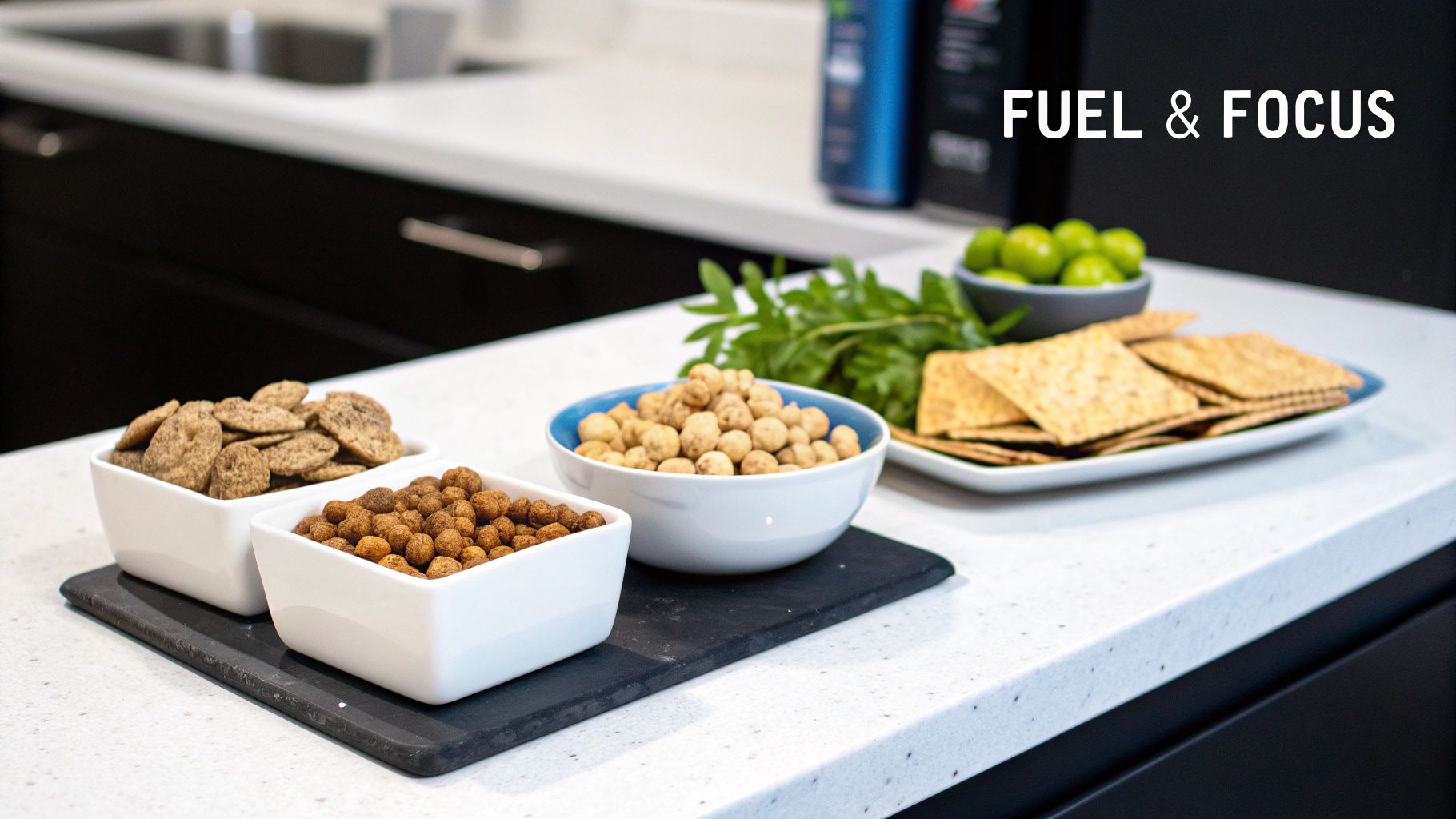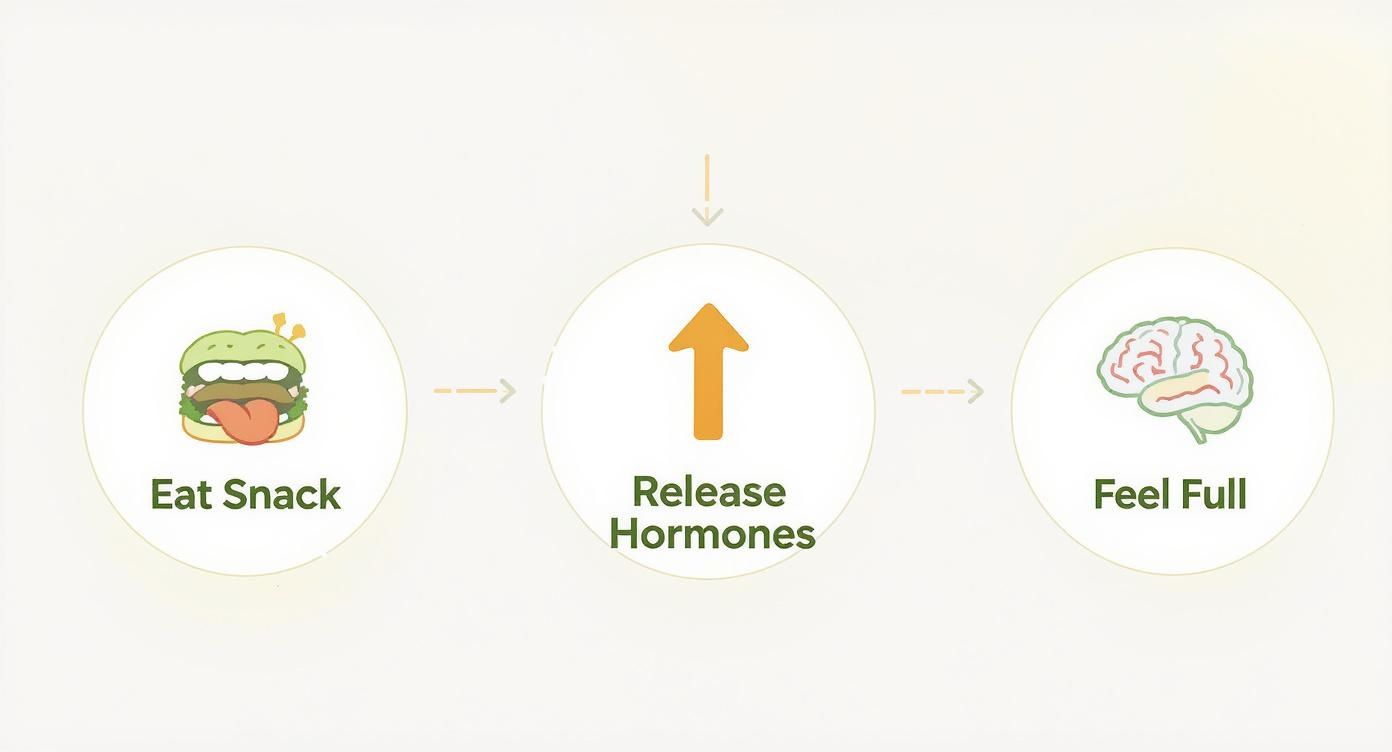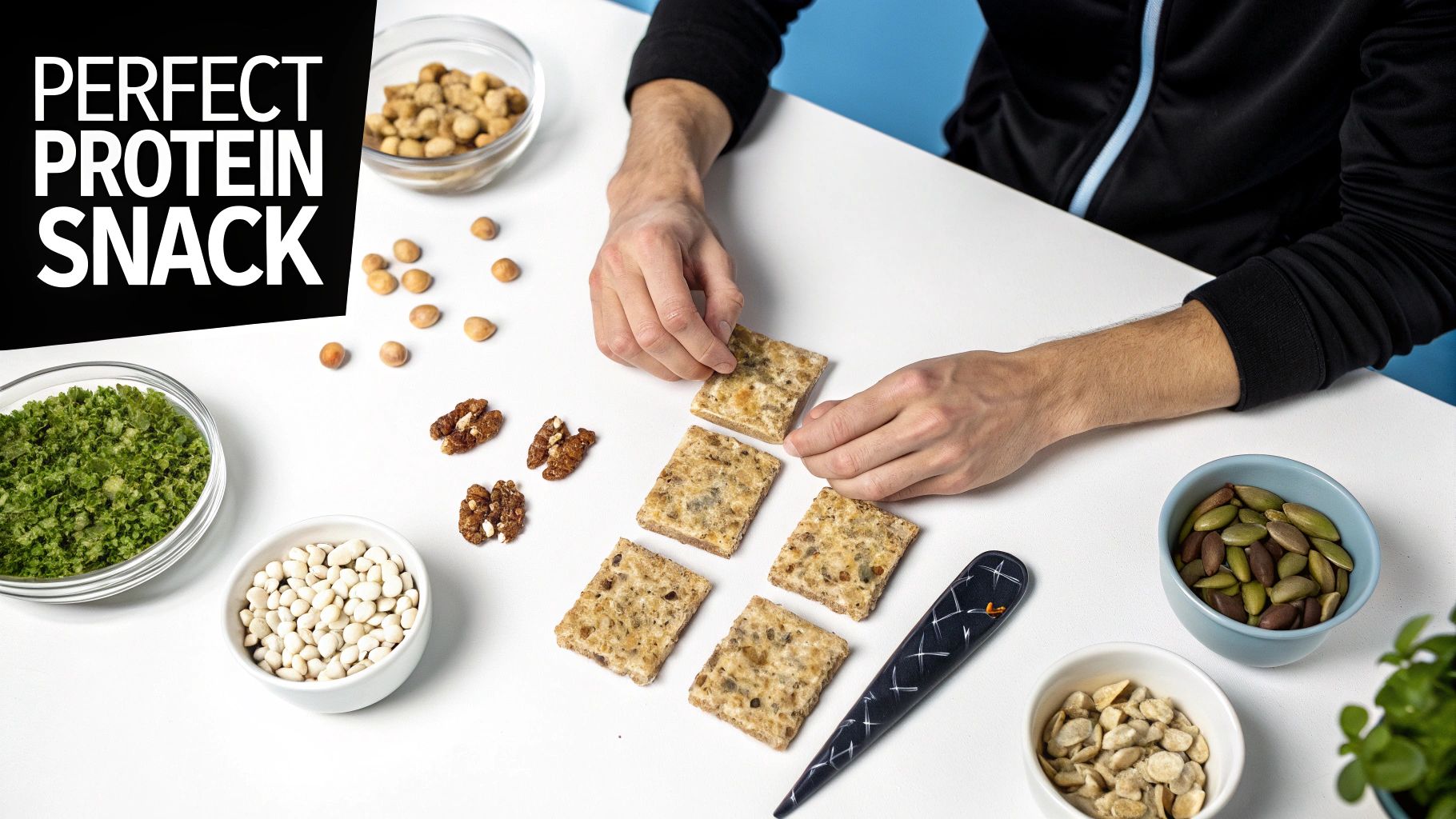
Your Guide to Crunchy High Protein Snacks
Share
When you think "snack," what comes to mind? For many, it's the satisfying crunch of potato chips or crackers. The problem is, those snacks often leave you feeling hungry just a short while later. Crunchy high-protein snacks are a game-changer, designed to give you that same crispy texture but with a serious nutritional punch.
They pack in muscle-building fuel and hunger-crushing satisfaction, making them a much smarter choice than the usual carb-loaded options.
The Rise of Crunchy High Protein Snacks

Ever demolished a bag of chips only to find your stomach rumbling again almost immediately? You're not alone. Most traditional crunchy snacks are loaded with simple carbs and fats. They send your blood sugar on a roller coaster—a quick spike followed by a hard crash that kills your energy and leaves you wanting more. It's a frustrating cycle that can easily derail your fitness goals.
This is exactly why a whole new category of snacks has exploded in popularity. Everyone from serious athletes to busy professionals is looking for a better way to fuel their day, and they're finding it in high-protein snacks. These aren't just empty calories; they're functional foods built to deliver real benefits alongside that satisfying crunch.
The Power of Protein and Crunch
The secret sauce is a simple but incredibly effective combination: protein and texture.
Protein is hands-down the most satiating macronutrient. It helps you feel full and stay full. When you eat a snack that's rich in protein, it helps keep your blood sugar steady and tells your brain you're satisfied, which helps put the brakes on hunger pangs.
That feeling of fullness gets a major boost from the physical act of chewing something crunchy. The texture itself is psychologically rewarding, helping to stomp out cravings for less healthy junk food.
Think of it as a one-two punch:
- Satiety: The protein gets to work internally, keeping you full and preventing you from overeating.
- Satisfaction: The crunch delivers that immediate sensory feedback that makes snacking so enjoyable.
This dual-action approach is what makes these snacks so effective for managing your appetite, fueling your workouts, or just surviving that 3 p.m. energy slump.
To see just how different these options are, let's look at a quick side-by-side comparison.
Crunchy High Protein Snacks vs Traditional Snacks
This table breaks down the core differences between a thoughtfully designed protein snack and your typical bag of chips.
| Feature | Crunchy High Protein Snacks | Traditional Crunchy Snacks (e.g., Potato Chips) |
|---|---|---|
| Primary Macronutrient | Protein | Carbohydrates & Fat |
| Satiety Effect | High (keeps you full longer) | Low (often leads to more cravings) |
| Blood Sugar Impact | Minimal spike, stable energy | Rapid spike and crash |
| Muscle Support | Promotes muscle repair and growth | Negligible |
| Common Ingredients | Whey, soy, pea protein, nuts, seeds | Potatoes, corn, refined flour, vegetable oils |
As you can see, the choice you make has a real impact on how your body feels and performs.
A Growing Global Trend
The move toward healthier snacking isn't a small trend—it's a massive global shift. The global protein snacks market was valued at an incredible USD 46.49 billion in 2023 and is expected to more than double in the coming years.
This kind of growth sends a clear message: people want smarter, more functional foods that fit their active lives. If you're curious, you can find more on these market trends in detailed industry reports.
The perfect crunchy high-protein snack does more than just fill a gap between meals—it actively supports your body. It helps repair muscle tissue after a workout, provides sustained energy without the crash, and keeps you on track with your nutritional goals.
By choosing snacks that put protein first, you're making a direct investment in your performance, your recovery, and your overall health—one delicious crunch at a time.
How Protein and Crunch Work Together to Beat Cravings
Ever demolish a bag of potato chips in minutes, only to feel hungry again an hour later? But then you have a crunchy, high-protein snack and feel satisfied for hours? That’s not a lack of willpower; it’s just your body’s chemistry at work. The one-two punch of protein and a satisfying crunch is a powerful combination for managing hunger right down to the hormonal level.
When you eat protein, it triggers your body to release specific hormones that signal fullness, like GLP-1 (glucagon-like peptide-1) and Peptide YY (PYY). You can think of these as little messengers that travel from your gut up to your brain with a simple, direct message: "Hey, we're good down here. You can stop eating." This signal is far stronger and lasts much longer with protein than it does with fats or simple carbs.
Think of your metabolism like a campfire. Tossing simple carbs (like chips or sugary snacks) onto it is like throwing on a handful of kindling. You get a quick, bright flare-up of energy, but it burns out fast, leaving you needing more fuel. Protein, on the other hand, is like adding a solid, slow-burning log. It provides steady, sustained energy that keeps the fire glowing for hours, preventing those sudden hunger pangs and energy crashes.
The Hidden Calorie Burn: Thermic Effect of Food
Beyond just making you feel full, protein has another trick up its sleeve called the thermic effect of food (TEF). This is simply the energy your body uses to digest and process the food you eat. It turns out, your body has to work a lot harder to break down protein than other nutrients.
Here’s a rough idea of how many calories your body burns just through digestion:
- Protein: Your body burns 20-30% of the calories from protein just to process it.
- Carbohydrates: The burn is much lower, around 5-10%.
- Fats: Your body barely breaks a sweat, burning only 0-3%.
So, for every 100 calories of protein you eat, your body uses up to 30 of those calories just for digestion. It's like getting a small metabolic boost with every bite, which makes high-protein snacks an incredibly smart choice for anyone focused on weight management or building a leaner physique.
Why That Crunch is So Important
While protein is handling the internal chemistry, the crunchy texture provides immediate mental and sensory satisfaction. The simple act of chewing something with a solid, crispy bite sends signals of gratification to your brain. This sensory experience is often what we're really after when a craving hits, and it can be powerful enough to stop you from reaching for junk food.
The combination is what makes it work. Protein gives you that deep, physiological satiety that keeps you full for hours. The crunch delivers the instant sensory reward that makes the snack feel satisfying right now.
This dual-action approach is what makes a crunchy, high-protein snack so effective. It satisfies your body's biological need for lasting energy and your brain's psychological desire for a pleasing texture. It’s your best defense against mindless snacking and the dreaded afternoon slump.
How to Read a Snack Nutrition Label
Walking down the snack aisle can be a dizzying experience. Flashy packaging and bold health claims scream for your attention, but they often mask ingredients that won't do you any favors. To pick a genuinely good crunchy, high-protein snack, you have to become a savvy detective and look past the marketing hype. Your best tool? The nutrition label.
Think of the nutrition label as the honest, no-fluff truth behind the product. The front of the bag is the story the brand wants to tell you; the back is the story you need to hear. Learning to decode it is the single most powerful skill you can have when it comes to smart snacking.
The Most Important Metric: The Protein-to-Calorie Ratio
When you pick up a snack, the first thing your eyes should dart to is the protein and calorie count. From there, you can figure out the protein-to-calorie ratio, a simple but incredibly revealing metric. It cuts right through the noise and tells you if a snack is actually protein-dense or just high in calories.
A solid benchmark to aim for is at least 10 grams of protein for every 100 calories. A snack that hits this ratio is giving you a serious protein punch for the energy it provides. It's the difference between a snack that builds muscle and keeps you full, and one that just loads you up with empty calories from fats and sugars.
Beyond the Numbers: Ingredients Tell the Real Story
After you've checked the macros, flip over to the ingredients list. This is where you separate the truly high-quality snacks from the ones packed with cheap fillers. It’s pretty straightforward once you know what to look for.
Here’s a quick checklist of what to spot—and what to avoid:
- High-Quality Protein Sources: You want to see ingredients like pea protein, whey protein, nuts, and seeds right at the top of the list. These are the building blocks your body needs.
- Hidden Sugars: Keep an eye out for sneaky terms like corn syrup, dextrose, and maltodextrin. Food companies often use several different types of sugar so that "sugar" doesn't appear as the very first ingredient.
- Unhealthy Fats: If you see hydrogenated or partially hydrogenated oils on the list, put it back. These are just code for unhealthy trans fats.
- Artificial Additives: Scan for artificial flavors, colors, and preservatives. As a general rule, a shorter ingredient list full of words you can actually pronounce is a much better sign.
This simple process—eating a protein-rich snack, kicking your satiety hormones into gear, and feeling genuinely full—is how you start to master your cravings.

As you can see, the benefits are baked right into our biology; it’s not just about willpower. When you choose the right snacks, you're literally working with your body's natural hunger-management systems, not against them.
By focusing on the protein-to-calorie ratio and scanning for clean ingredients, you empower yourself to see past flashy marketing. You'll be able to confidently choose snacks that align with your health goals, whether you're following a specific diet like keto or simply trying to eat better.
When to Eat Snacks for the Best Results
Knowing what to snack on is one thing, but knowing when is the key to unlocking real results. Timing your crunchy high-protein snacks isn't about following a strict schedule. It's about using them strategically to give your body exactly what it needs, right when it needs it.
There's a reason these snacks are exploding in popularity. The North American snack food industry has ballooned to $156 billion in sales, with a huge shift toward protein-rich options. In fact, meat-based snacks make up 55.64% of the market's revenue, and crunchy chips and crisps are the fastest-growing category of them all. People are clearly looking for snacks that do more than just quiet a rumbling stomach. You can dive deeper into these protein snack market dynamics to see the full picture.
Pre-Workout Fuel for Sustained Energy
Grabbing a crunchy, high-protein snack about 30 to 60 minutes before you hit the gym can completely change your workout. A sugary snack might give you a quick jolt, but it's always followed by an energy crash. Protein, on the other hand, delivers a steady stream of amino acids.
This slow-and-steady energy release helps protect your muscles from breaking down when you're pushing them hard. Think of it as putting fuel in the tank for the long haul, ensuring you have the power to finish that last set without running on empty.
The Critical Post-Workout Recovery Window
That 30-to-45-minute period right after your workout? That's what many call the "anabolic window." It’s the time when your muscles are primed to soak up nutrients to repair and rebuild.
Your muscles after a workout are like a construction site, full of tiny micro-tears that need fixing. Protein provides the amino acids—the raw building materials—to patch up that damage, helping you rebuild bigger and stronger than before.
Having a convenient, crunchy snack ready to go is the perfect way to kickstart that recovery process immediately, without the hassle of making a full meal. This one simple habit can dramatically cut down on muscle soreness and get you back in the gym feeling strong.
Beating the Midday Slump and Late-Night Cravings
Your snacking strategy doesn't have to revolve solely around the gym. Smart timing can help you manage your energy and hunger levels all day long.
When that classic 3 PM slump hits, a protein-packed snack is your best friend. It stabilizes blood sugar levels and sharpens your focus, giving you the boost you need to cruise through the rest of the afternoon.
Likewise, a light, protein-forward snack before bed can curb those late-night cravings while feeding your muscles as you sleep. It provides a slow release of nutrients for overnight recovery, so you wake up feeling refreshed and ready to go—not starving.
The Art of Crafting the Perfect Protein Snack

Making a genuinely great crunchy protein snack is more than just cramming protein into a bag. It's a real balancing act, a careful blend of nutrition, flavor, and that all-important texture to create something that actually helps your body while hitting the spot when cravings strike. Getting from a concept to the finished product is a journey of thoughtful decisions.
It all starts with the protein itself. By choosing a premium, complete protein like pea protein, we ensure you’re getting all the essential amino acids your muscles are crying out for. This is the bedrock of the entire snack, making sure it’s effective from the very first bite.
From there, it’s all about a clean-label philosophy. This isn't just a buzzword; it's a commitment to leaving out the junk—no fillers, artificial ingredients, or common allergens like dairy, soy, and gluten. The aim is to make a snack that’s as easy on your gut as it is beneficial for your goals.
Balancing Macros for Peak Performance
A top-tier snack isn't just high in protein; it’s smart about all its macros. The trick is to create a nutritional profile that works for a variety of goals, whether you're building lean muscle or just trying to manage your weight. By keeping unhealthy fats and added sugars out of the picture, the snack can provide sustained energy without the dreaded crash.
This careful balance is what makes a snack truly versatile. It can fit seamlessly into your day as pre-workout fuel, a post-workout recovery tool, or just something to get you through that 3 p.m. slump.
The real art lies in making nutrition crave-worthy. It’s about merging that deeply satisfying, audible crunch with bold, savory flavors that provide a psychological reward, helping you stay consistent with your health goals.
The Growing Demand for Better Snacking
This shift toward smarter, cleaner options isn't just a niche trend; the market is booming. The global protein snacks market is on track to hit US$ 8,624.3 million by 2032. What's really telling is that plant-based options are leading the charge, capturing over 62.8% of the market share.
This incredible growth proves one thing: people are demanding snacks that deliver on both taste and transparency. You can dig deeper into the rise of plant-based protein snacks to see just how big this movement has become.
Ultimately, the perfect modern protein snack is a fusion of food science and culinary craft. It’s the proof you’ve been looking for that you never have to choose between what tastes good and what’s actually good for you.
Got Questions About Protein Snacking? We’ve Got Answers.
Jumping into the world of high-protein snacks usually brings up a few questions. How many is too many? Can they really help with weight loss? Will they make me bulky? It's easy to get lost in the noise, so let's cut through the confusion and tackle these common questions head-on.
How Many High-Protein Snacks Should I Eat in a Day?
For most active people, one or two high-protein snacks a day is the sweet spot. Think of them as bridges between your main meals—not meal replacements. They’re perfect for kickstarting recovery right after a workout or stopping that 3 PM hunger pang before it sends you straight to the vending machine.
Ultimately, the right number for you boils down to your personal activity level, overall calorie needs, and how much protein you're aiming for. The goal is to use them strategically to hit your daily targets without piling on a ton of extra calories.
A well-timed snack does more than just fill you up; it complements your main meals to ensure your body has a steady supply of the nutrients it needs to perform, recover, and thrive.
Are Crunchy High-Protein Snacks Actually Good For Weight Loss?
Absolutely. They can be a game-changer if you're trying to lose weight. Protein is the most satiating macronutrient, which is just a fancy way of saying it helps you feel full and satisfied for longer. That feeling of fullness makes it so much easier to sidestep those cravings for sugary, high-calorie junk food.
There's another cool benefit, too. Your body burns more calories digesting protein than it does for carbs or fats. This is called the thermic effect of food, and it gives your metabolism a nice little nudge. Plus, that satisfying crunch can trick your brain into thinking you're having a less-healthy treat like potato chips, satisfying the craving without the guilt. Just be sure to pick snacks with a solid protein-to-calorie ratio and minimal added sugar.
Is It Okay to Eat a High-Protein Snack Before Bed?
You bet. A protein snack before hitting the hay can be a brilliant move, especially if muscle growth and recovery are on your radar. It provides your body with a slow and steady supply of amino acids throughout the night, which helps prevent muscle breakdown and supports the repair process that kicks into high gear while you sleep.
The key is to choose something low in sugar and simple carbs so you don't mess with your sleep. A smart, portion-controlled snack is a great way to handle late-night hunger and wake up feeling refreshed instead of starving.
Will Eating High-Protein Snacks Make Me Bulky?
Let's bust this myth once and for all: no, high-protein snacks will not automatically make you bulky. Getting "bulky" is hard work and requires a very specific, deliberate recipe of training and nutrition.
To actually build significant bulk, you need two things:
- Intense Resistance Training: We're talking about consistently lifting heavy and pushing your limits.
- A Serious Calorie Surplus: This means eating way more calories than you burn, day in and day out.
For the average person, adding a crunchy, high-protein snack into a balanced diet simply helps build and maintain lean muscle, speeds up recovery, and keeps you feeling full. It’s fuel for your goals, not a shortcut to unwanted size. A snack with 15-20 grams of protein is the perfect amount to support a lean, athletic build without sending your calories through the roof.
Ready to experience the perfect balance of savory flavor, satisfying crunch, and clean, plant-based protein? Gym Snack delivers chef-inspired taste with a macro-friendly profile to fuel your goals. Build your custom pack today.
